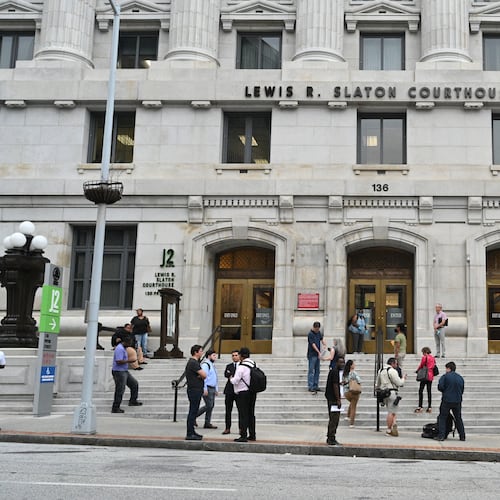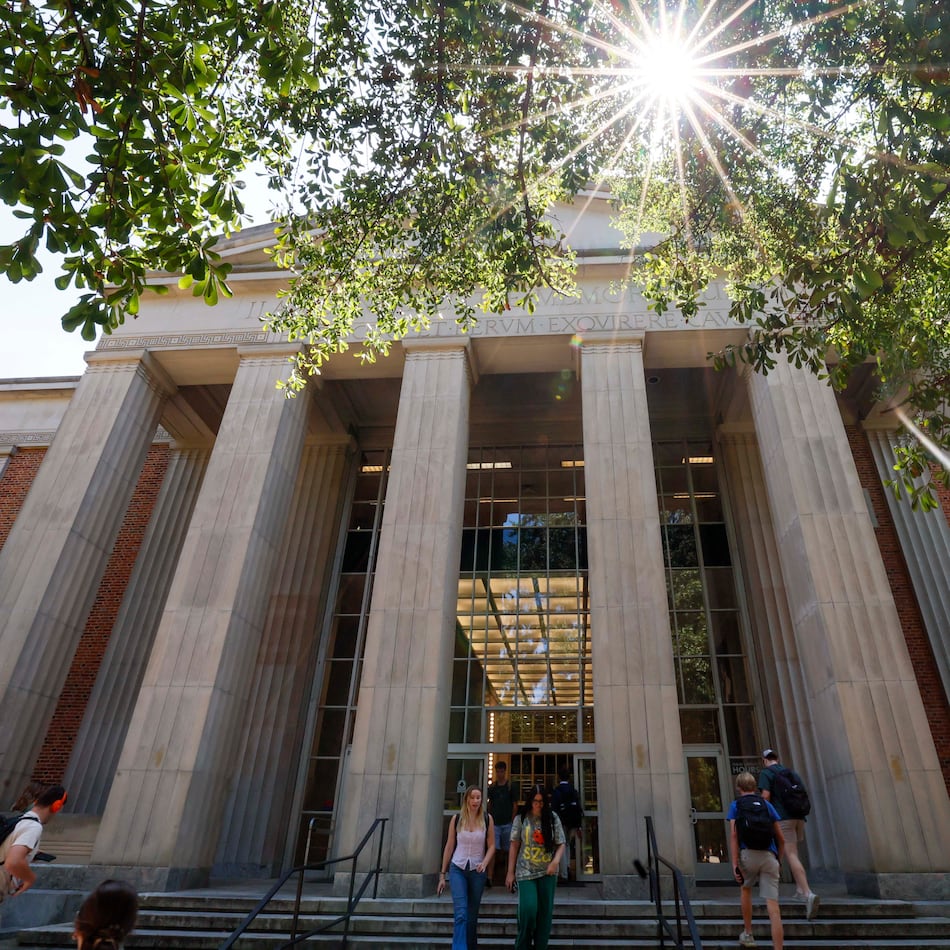Stewart County’s students quietly filed into their cafeteria this week for a lunch complete with chicken, multigrain waffles, broccoli and milk. The meals are free for all of the South Georgia county’s 515 public school students. So are their breakfasts. And if the county wins a federal grant, its students could start receiving free dinners as soon as next year.
A rural community with just 5,700 residents, Stewart was singled out in a U.S. Census Bureau report this month for being one of the poorest counties in the nation. The county has one of the highest percentages of families living in poverty at 38.4 percent.
“I worry about the kids because sometimes I know the only meal they get is what they eat in school,” Mona Hubbard, the county school system’s nutrition manager, said as she supervised Monday’s lunch preparations. “If your stomach is growling, how can you pay attention?”
Georgia House members have been studying the problems facing Stewart and other rural parts of the state for months, and now they’re preparing to do something about it. Their Rural Development Council will release its first report Wednesday, and its recommendations could be made into law as soon as next year.
Among the options up for consideration are state grants for expanding high-speed internet access in rural communities. Young doctors could be offered college loan relief if they agree to work in rural areas. Hospital record-keeping could be streamlined. And a pilot program could teach job skills to rural residents.
“There’s not a silver bullet. You’ve got to improve a lot of issues to make rural Georgia attractive for job creation,” said state Rep. Jay Powell, R-Camilla, one of the council’s co-chairmen.
To illuminate Stewart’s poverty, journalists from The Atlanta Journal-Constitution crisscrossed the county this week, speaking with many of its residents, community leaders and businessmen. Their accounts revealed Stewart’s challenges are complex, multifaceted and not dissimilar to problems facing other rural communities.
Sitting south of Columbus on the Alabama border, Stewart is an isolated county with a dearth of jobs, doctors, grocery stores and restaurants. The county suffered a major blow four years ago when Stewart-Webster Hospital in Richland closed its doors.
The county’s wish list is long and growing. Stewart’s school system, for example, could use additional funding for teacher salaries; classroom computer equipment; and new athletic fields, Superintendent Valerie Roberts said.
The school system is one of the biggest employers in the county, yet most of its teachers don’t live there. Roberts, for example, commutes to Lumpkin from her home in neighboring Sumter County.
“There are some people that I personally know that went to school in Stewart County — professionals that are teachers and what have you — they are just not returning to Stewart County,” she said. “If you can go get a job in Atlanta or Columbus, that is what you are going to do.”
A church steps in
Worshippers see Stewart County’s challenges up close every day they walk out the front door of Ebenezer Missionary Baptist Church in Lumpkin. There across Martin Luther King Jr. Boulevard sits a vacant yellow house with a gaping hole in its roof. Next to it is an empty lot choked with weeds. And next to that sits another vacant house with a sagging front porch.
The view remains grim on the blighted ride north into Lumpkin’s sleepy downtown. Dilapidated buildings, piles of junk and bare concrete foundations scar the route to the city’s main square, where the county courthouse sits.
The Rev. Lawrence Bryant, a Lee County native, wondered whether he had made a mistake when he moved to Lumpkin nine years ago to lead Ebenezer and saw the decay.
“With my arrogance and my high-mindedness, I was like, ‘There is no way in the world I want to be here,’ ” he said over lunch at Snooky’s, one of the few places to eat in Lumpkin. “But when I got to the church … something let me know I was home.”
Bryant’s 85-person church — its membership has fallen in recent years as people have moved away from Stewart — has set to work ministering to the homeless, feeding the needy and building a multipurpose room where Lumpkin’s children can play. Bryant and his parishioners have many other dreams. They want to build a playground, create a Christian school and start a job-training center.
Kimberly Seldon, a former Lumpkin city councilwoman who sings at Ebenezer, said the city needs a library and help dealing with thorny problems, such as drug addiction and teenage pregnancy. She stressed the importance of unity in Stewart, a majority-black county.
“We need to bridge the gap of this side and that side — the black side and the white side,” she said. “There are some things the black community can contribute. … And there are some things the white community can contribute to the whole county.”
Trishana Jones, another Ebenezer parishioner, wants to see more jobs come to her county. For the past 18 years, she has traveled an hour each way to Columbus, where she works at a residential treatment facility.
“Opportunities here that would pay a decent salary — that would be great,” she said, adding Lumpkin could also use a major grocery store. “If I want fruit, I have to go eight miles to Richland.”
Joann Chester, a retired elementary school principal, said both of her children left Stewart after graduating from high school. Her son is a middle school principal in Fulton County and her daughter works at a behavioral health care organization in Newnan.
“Your better students — those that have the ability — leave because there is nothing to offer here,” she said.
Bryant squarely addressed the county’s plight in an impassioned sermon Sunday.
“Your faith may be the size of mustard seed, but that faith we know can move mountains,” he said as he mopped his sweaty brow with a towel. “That same faith can bring all the things the enemy thinks he took from this community. But how many know we may have lost a lot of things, but we have not lost our faith?”
Beer, rum, hope
Stewart County Manager Mac Moye’s heart sank as he drove his white pickup truck down the road past Bryant’s church and spotted Historic Westville, an outdoor living history museum that once drew tens of thousands of tourists to the county each year. Now being dismantled, it is scheduled to reopen next year in Columbus. Moye once led the museum, which includes many Georgia artifacts and historic buildings.
“It just breaks my heart to see this,” he said. “Good Lord, I am just stunned.”
But all is not lost, Moye said as he showed a visitor the county’s enduring attractions. He traveled to the rim of Providence Canyon, a series of massive gullies nicknamed Georgia’s “Little Grand Canyon,” and marveled at its enormousness. And then he drove to Florence Marina State Park, where he gazed at the placid Walter F. George Lake. Both parks bring many visitors to Stewart and have the potential to attract even more, he said.
The county, meanwhile, has convened a group of residents focused on Stewart’s future. Among the group’s first conclusions: Stewart needs more affordable housing — of good quality — to keep workers in the county. Stewart’s largest employer is a privately operated immigration detention center in Lumpkin. Of the center’s 360 employees, less than one-third are Stewart residents, Moye said. More might live in Stewart, he said, if they could find homes there. Meanwhile, revenue from the detention center’s operation funds about one-fifth of the county’s annual $4.1 million operating budget, Moye said.
Moye pointed to two bright spots in Stewart, Richland Distilling Co. and Omaha Brewing Co. Together, both businesses have made substantial investments in Stewart and are attracting thousands of people there each year.
Dr. Robert Lee, a dentist who started brewing four years ago in his hometown near the Alabama border, is now selling his beers across the state and in southeast Alabama. He makes 70 different brews out of a former elementary school. Between his dentistry and his brewery, he employs 26 people. He is planning to open a country and bluegrass music venue and winery on his property.
Erik Vonk, a native of the Netherlands who immigrated to America for work, started growing sugar cane on his farm in South Georgia as a hobby in the late 1990s. His rum distillery now employs six people and occupies seven buildings in downtown Richland, all of which were once boarded up. His rum sells in 15 states and nine countries. Vonk is opening a branch in Brunswick.
Business tax relief, a trained workforce and affordable high-speed internet access would help Stewart’s economy grow, Vonk and Lee said.
“We need more businesses like Omaha Brewing and Richland Rum in the county,” Vonk said. “Business begets business, gradually allowing us to employ more people, draw more businesses, generate more sales taxes and establish a tiny little backbone for commerce.”
Stewart County snapshot
2016 population: 5,705
2010 population: 6,058
Population under 18: 13.8 percent
Population 65 and over: 15.6 percent
White residents: 44.5 percent
Black residents: 50.8 percent
Median home value: $52,200
Median household income: $20,882
Families living in poverty: 38.4 percent
Source: U.S. Census Bureau
Never miss a minute of what’s happening in Georgia Politics. Subscribe to PoliticallyGeorgia.com.
Keep Reading
The Latest
Featured




